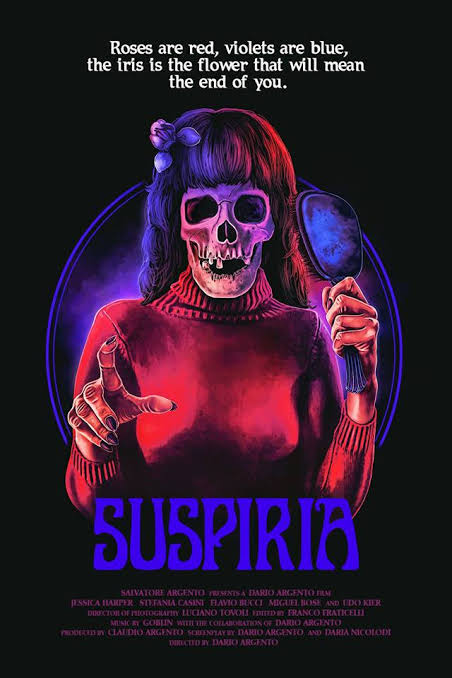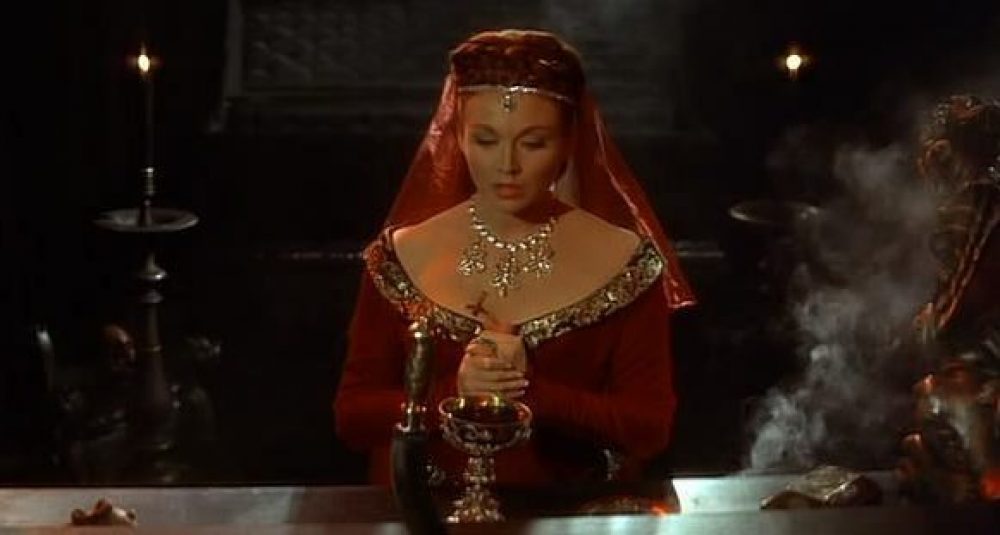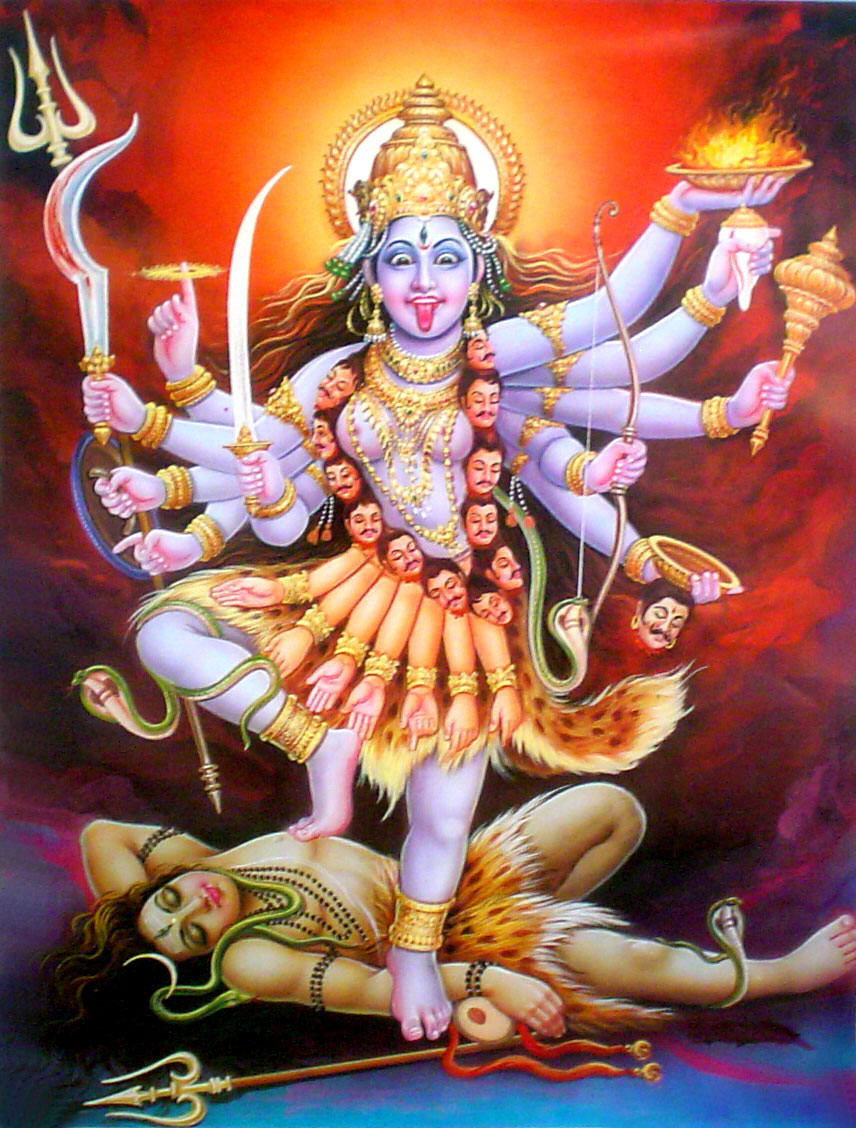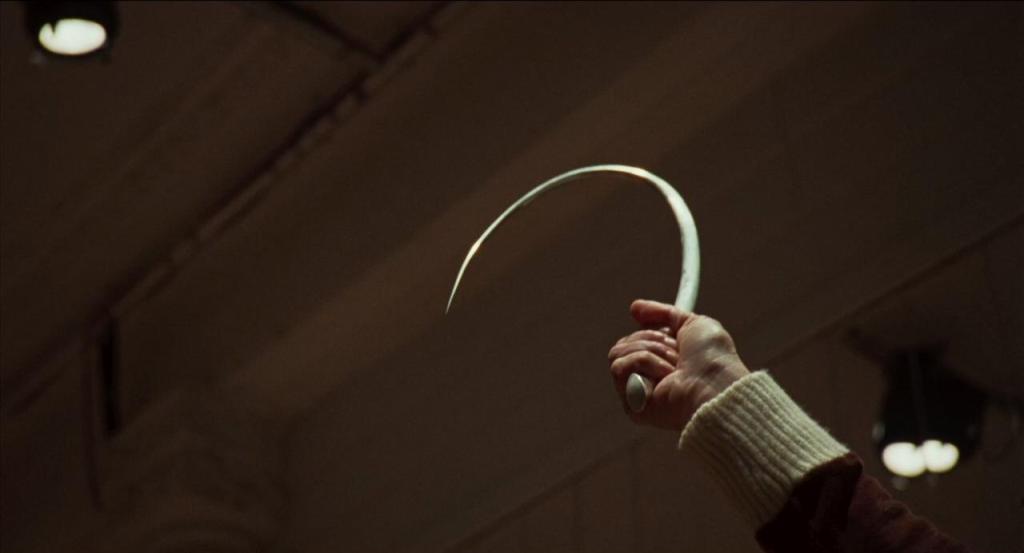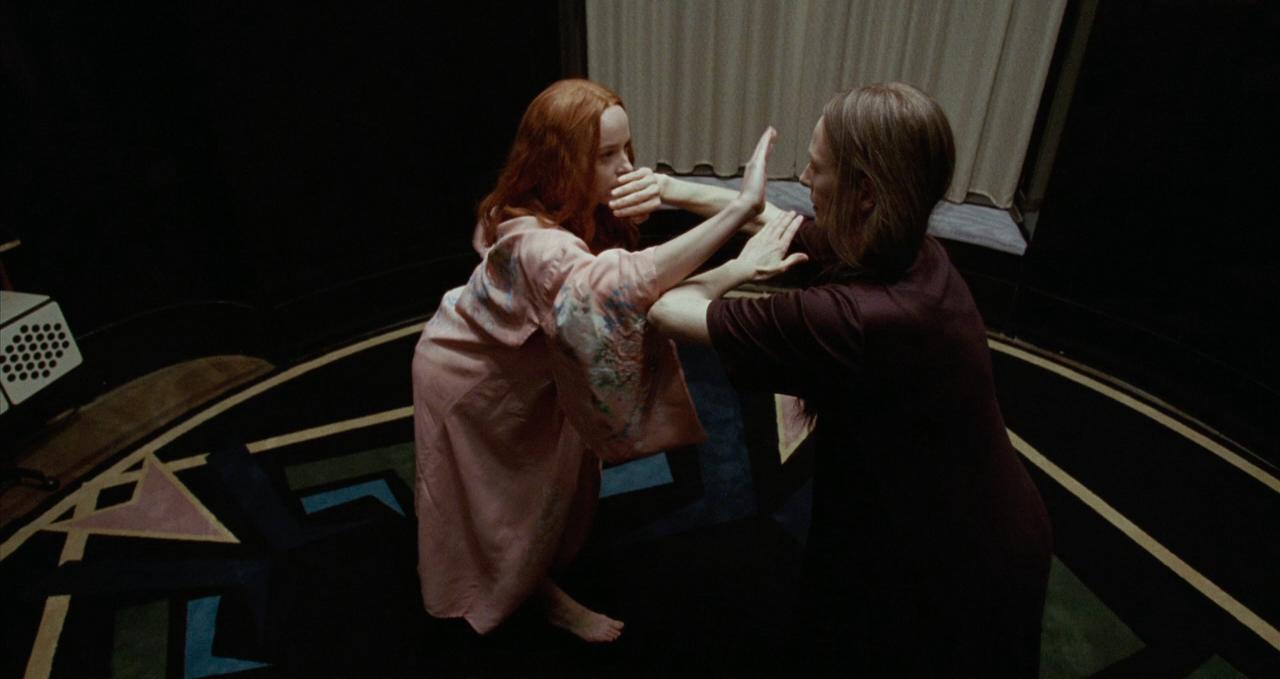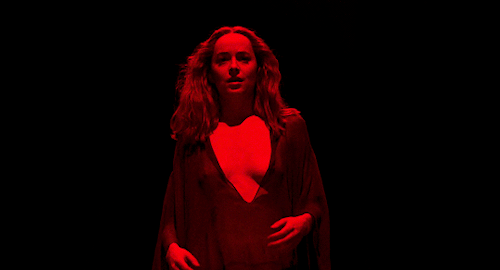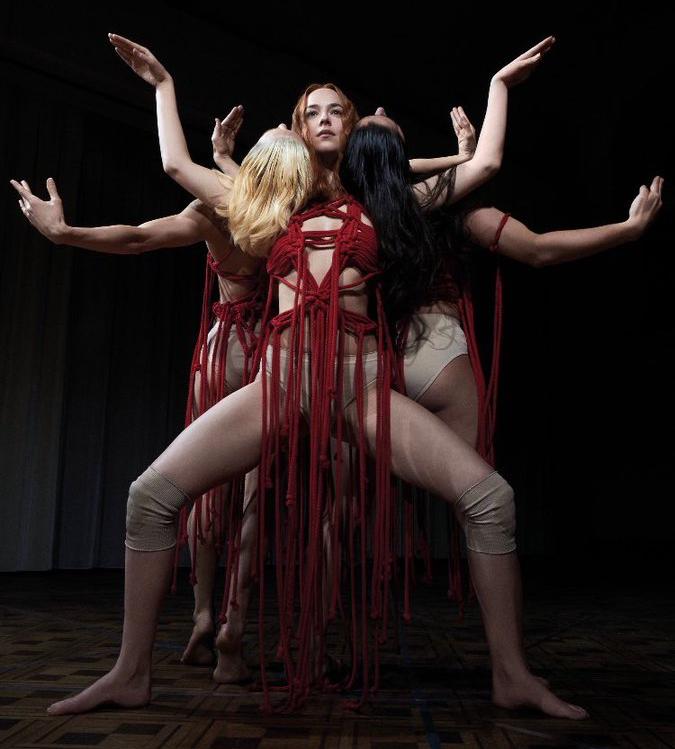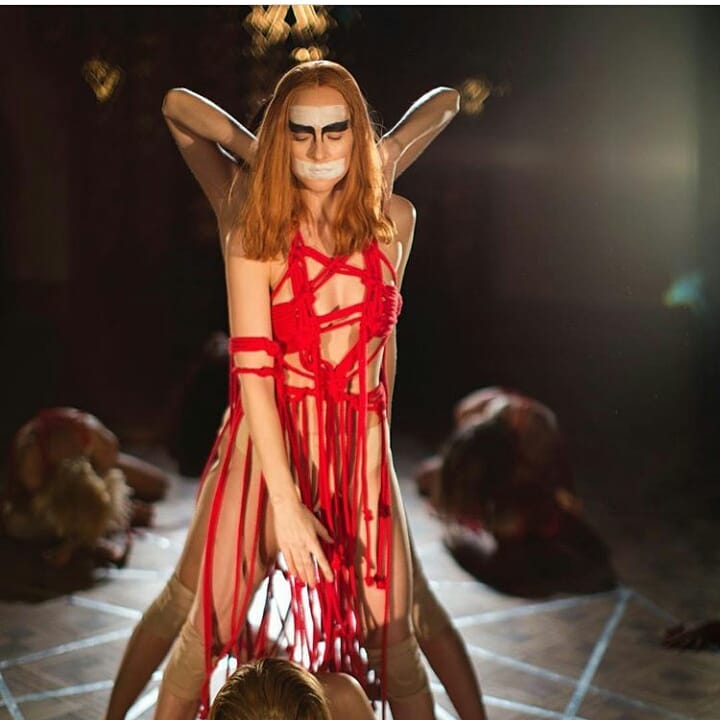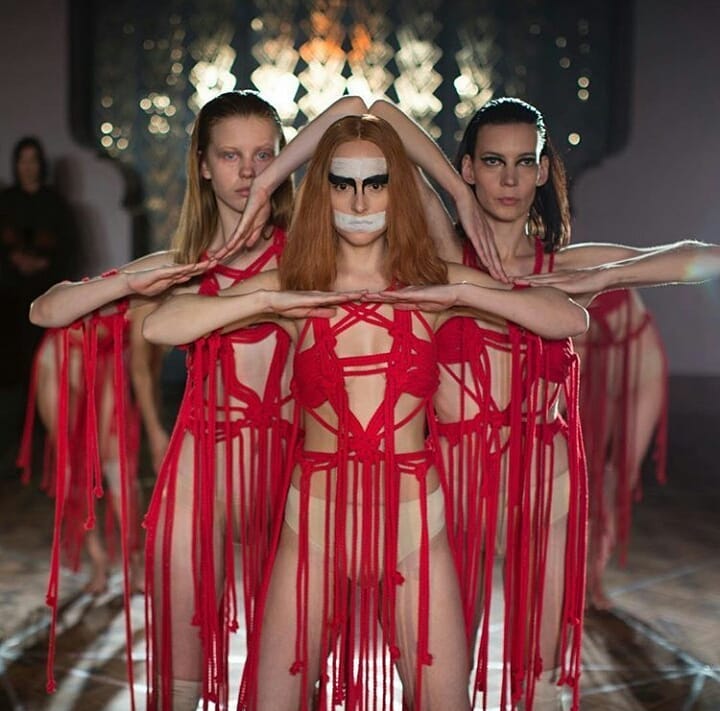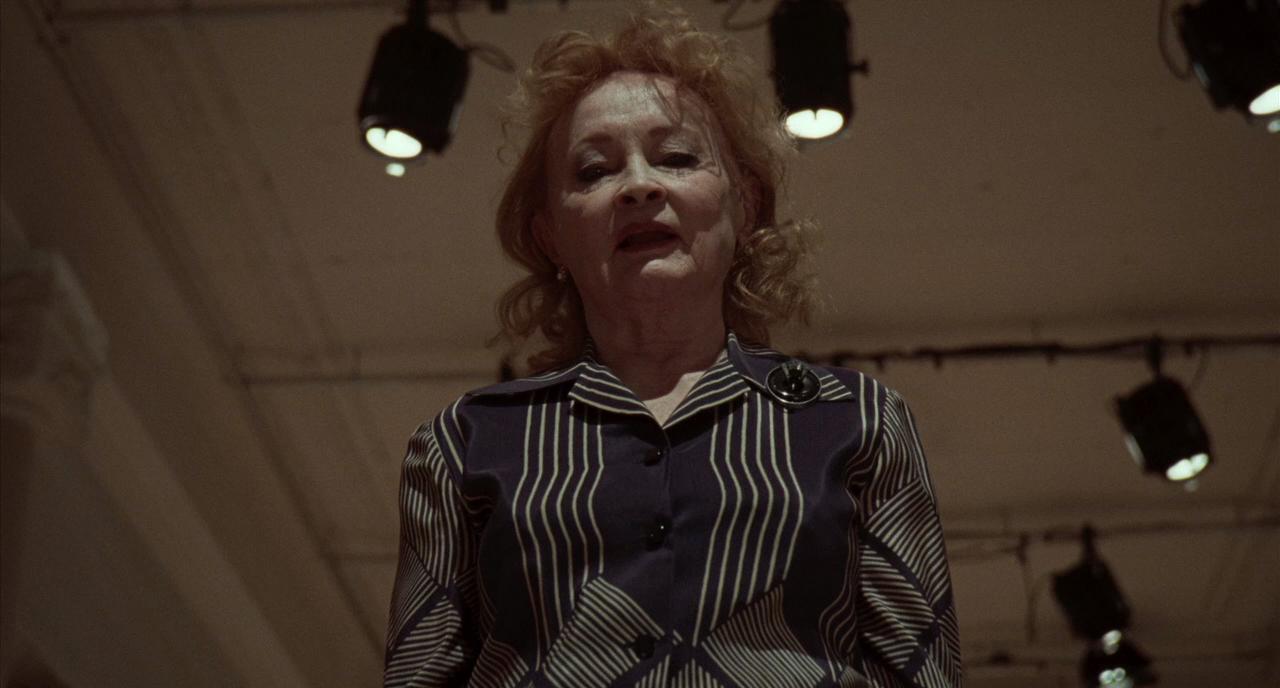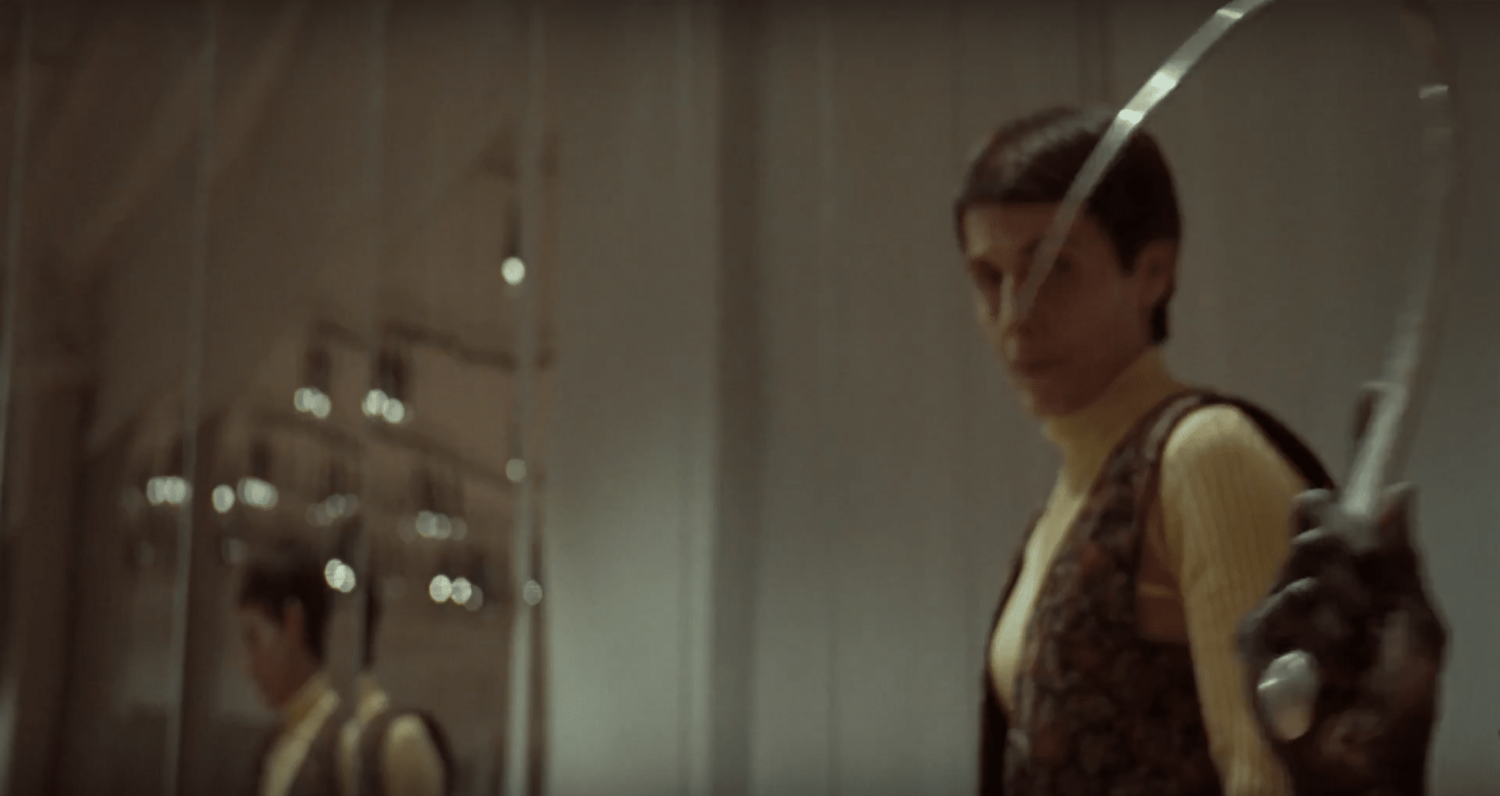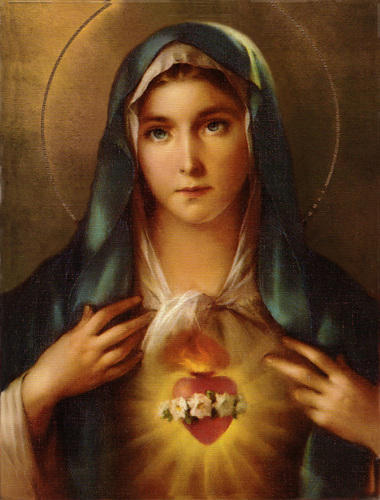By: Rafael Espadine
Rafael Espadine is an artist and Philosophy student, researcher on the occult and ancient spiritual cultures. He works in the field of Indian culture. He is our first contributing writer to Devil In the Details. His work may be viewed at: Spadini Arts and @r.spadini (Instagram).

Dakota Johnson as Susie Bannion, Suspiria 2018.
Luca Guadagnino’s rebooted Suspiria (2018) has certainly surprised both followers of the cult classic and newcomers alike. It is a beautiful, lengthy, haunting, multi-layered and dreamy depiction or better saying, experience. And it has witches. That’s the very rare combination that every admirer of the occult expects to see when going for a supernatural movie. Dario Argento’s Suspiria (1977) — I’m not calling it “the original one” on purpose, for both films are too original to be compared — has that quality of attracting the esoterically minded too; and it stands at its own place of honor for that occult taste as well as for its aesthetics, among other reasons. Whereas the first film shows the two sides of the story by clearly dividing the good girls from the bad ones in a more typical representation of good versus evil, the new take of Suspiria leaves much space for questioning, but it seems that “space”, and how it may or may not be filled, is precisely one of the key words of the reinvented plot. By not totally following the new trend of completely rectifying the story of well-known villains by portraying them as betrayed, and unjustly vilified creatures (as done in the plots of Maleficent and Wicked, for instance), perhaps what Guadagnino’s Suspiria remarkably does is to show us a type of horror — for lack of a better term — that, we could say, is almost an unavoidable part of Nature itself. This horror is beyond most any human comprehension of the cosmos and is not just a mere fruit of human cruelty although mixed with it at times. It presents what could be easily seen as opposite sides of a coin, blurring frontiers; and how the two sides really look to be parts of a single coin now!

After this brief appraisal, what’s presented next is a short analysis that aims to stir a possible new interpretation for the central and unique mystery of the new version of Suspiria out of the symbology present in the name of the character that goes through the deepest transformation, while also causing major changes around her: Suzy Bannion.
I’ll assume that the reader of such a focused analysis is a connoisseur of both films and that the two works can be treated as classics (yes, even the new one already), so major plot details are freely discussed here.
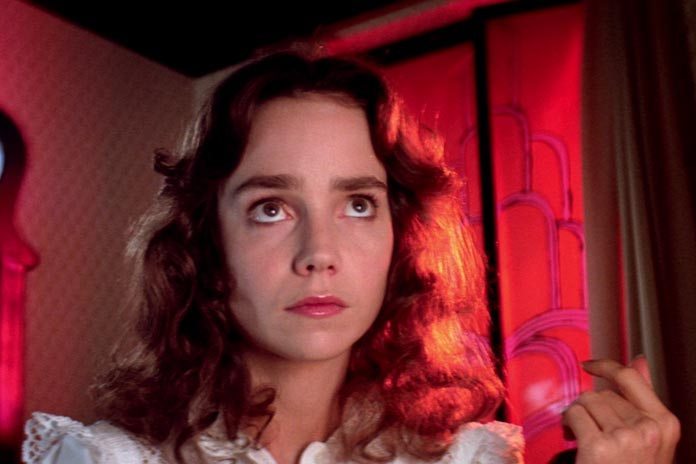
Jessica Harper as Suzy Bannion. Suspiria (1977).
The name: Susanna, Suzy, Susie
Sources are varying in the spelling of the short version of the name, but if we are to trust the official records and the subtitling, the full name of the main character would be Susanna Bannion, with short forms varying from Suzy in Argento’s production and Susie in Guadagnino’s version.
Now Susanna, a feminine personal name widely used across the globe, is itself very interesting. Derived from the Hebrew Shoshannah (שושנה), with the most common spelling coming to us via Greek form Σουσάννα (Sousanna), making the S letters softer, this Hebrew word is also transliterated as shūshan, shōshan and shōshannā, and means simply “lily”, the flower (while lily is derived from the Latin lilium). Many flowers in the past have been designated by that name, including the so-called water lilies. Now the implications of the lily as a symbol, the heraldic fleur-de-lis (which literally means “lily flower” in French), the symbol of the six-pointed star, its connection to moon spirits and deities, the annunciation of the Virgin and Mary herself , Lilith — besides royal families and bloodlines — are endless (and who needs another book on that?). For those acquainted with the plot, the final discovery of the first heroine is through a very similar flower: an iris; whose shape also follows that of the fleur-the-lis pattern, i.e., three petals turned upwards, and three petals turned downwards. The flower seems to be missing in the new version (although one room is named iris in the new film as an obvious reference), but isn’t the new Susie haunted by a nocturnal flowering light in her bedroom that will lead her way to her final discovery/empowerment? A side note: Cinematic-wise we may cite another contemporary dance themed psychological thriller that also hints at Lilith’s disruptive power as a dark independent feminine principle that promotes drastic changes: Lily is the name of the lavishly sensual ballerina from Black Swan that so shockingly contrasts with the fragile and candid Nina and who also paves the way for the latter’s transformation. Her name leaves very little to be revealed…
“Lilith is the universal rule breaker”
The Lilithian theme seems to fit the character of Susie very well, especially the new Suspiria. The theme is that of the shattering of the old order by means of a rebellious behaviour, and that is the biggest fear of Western civilization and it’s created illusions of continuity, valor, and rigid legacy. If it comes from women then, there’s even more to be feared, given the millennia of prejudice against women and against the feminine in itself. Lilith is the universal rule breaker. However, as pointed by the Italian occultist Fulvio Rendhell, a renowned medium and magician still active in Rome, in his ‘Lilith la terrorista cosmica’ (Lilith, the cosmic terrorist ) — part of the book Lilith, la Sposa di Satana nell’Alta Magia a rare and authoritative treatise on the dark feminine — any revolution stiffens, gets institutionalized as norm and establishes new rigid dogmas and therefore, will have to be destroyed in due course by another revolution and so on and on endlessly. In astrology, Lilith is, among many other possible interpretations, an aspect of the non-normative: wherever she rules the aspect she is presiding over must irrevocably be fulfilled by unusual courses of action for the usual ones simply won’t work out.
In various philosophical approaches, the end of something and its transmutation into something new is the very way life itself manifests; and if we could perceive every transformation, we would see it happens all the time, and that every instant is made of that: an eternal “becoming”. The insistence in connecting the basic theme of the Three Mothers and Alchemy, both in Argento’s Suspiria (1977) and Inferno (1980) are quite revealing: the mothers could be symbols of the alchemic stages of Nigredo, Rubedo and Albedo. Besides that, sighs could be seen as a negative manifestation of air, tears of the inner emotional turmoil, and darkness as the opposite to light and an all-encompassing factor, essential for the symbolism of the dark feminine in various cultural and spiritual backgrounds. Curiously the Kabbalah recognizes three basic elements: air, water and fire. Earth in this interpretation would be a gross manifestation resulting from the amalgama of the other three elements mentioned.

The surname: Bannion
According to genealogical records, the surname “Bannion” and its other forms are Welsh and derived from the personal name Eignion or Enion — from ‘einion’, stability, fortitude, the name of a clan ancestor — with the patronymic prefix “ab” added to it. The prefix would be later assimilated into the surname itself and from ab-Enion it would become Bannion. As a masculine name Enion may also mean “anvil”. An anvil as a symbol and allegory is very interesting in itself, but we are about to see a feminine version with most appealing implications: we will now briefly step into the very mystical universe of William Blake (1757–1827). In that rich and mesmerizing universe Enion is a character of the Gnostic mythology of Blake. She is an Emanation paired with Tharmas, one of the four Zoas, beings created from the division of the primordial human, Albion. Tharmas is an allegory for the sensations, whereas Enion of the sexual impulses and desires and both should be reunited after the Final Judgement when Enion will then consummate a sexual union. Blake’s Enion seems to be all “why is everyone so ready to think the worst is over?” in her every line, especially here in these selections from ‘The Four Zoas’.
[The Wail of Enion]:
(Four Zoas, Night II, ll. 595–626.)
I AM made to sow the thistle for wheat, the nettle for a nourishing dainty:
I have planted a false oath in the earth; it has brought forth a Poison Tree:
I have chosen the serpent for a counsellor, and the dog
For a schoolmaster to my children:
I have blotted out from light and living the dove and nightingale, 5
And I have causèd the earthworm to beg from door to door:
I have taught the thief a secret path into the house of the just:
I have taught pale Artifice to spread his nets upon the morning.
My heavens are brass, my earth is iron, my moon a clod of clay,
My sun a pestilence burning at noon, and a vapour of death in night. 10
What is the price of Experience? Do men buy it for a song,
Or Wisdom for a dance in the street? No! it is bought with the price
Of all that a man hath — his house, his wife, his children.
Wisdom is sold in the desolate market where none come to buy,
And in the wither’d field where the farmer ploughs for bread in vain. 15
It is an easy thing to triumph in the summer’s sun,
And in the vintage, and to sing on the waggon loaded with corn:
It is an easy thing to talk of patience to the afflicted,
To speak the laws of prudence to the houseless wanderer,
To listen to the hungry raven’s cry in wintry season, 20
When the red blood is fill’d with wine and with the marrow of lambs:
It is an easy thing to laugh at wrathful elements;
To hear the dog howl at the wintry door, the ox in the slaughterhouse moan;
To see a God on every wind and a blessing on every blast;
To hear sounds of Love in the thunderstorm that destroys our enemy’s house; 25
To rejoice in the blight that covers his field, and the sickness that cuts off his children,
While our olive and vine sing and laugh round our door, and our children bring fruits and flowers.
Then the groan and the dolour are quite forgotten, and the slave grinding at the mill,
And the captive in chains, and the poor in the prison, and the soldier in the field
When the shatter’d bone hath laid him groaning among the happier dead: 30
It is an easy thing to rejoice in the tents of prosperity —
Thus would I sing and thus rejoice; but it is not so with me.
Yes, dear Enion, we know… it’s all a mess. The one out there, the one in here.
In another interesting passage from the Four Zoas entitled Night the First, Blake’s poetry says a little more about Enion’s powers and strong personality that causes her to hurt her own creations:
“…Then Enion in jealous fear
[240] Murdered her, & hid her in her bosom, embalming her for fear
She would rise again to life. Embalmed in Enion’s bosom.
Enitharmon remains a corse — such thing was never known
In Eden, that one died a death never to be revived.”
While reading this passage it is difficult not to think of the living dead victimized students of both Suspirias, above all those of the new production, kept by the witches in an embalmed intermediary stage between life and death serving the witches mysterious purposes.

Sara (Mia Goth) falls under the spell of The Three Mothers in Suspiria.
A relation between Enion’s wails and the Mother of Sighs is easy to notice as both are presented as principles that predate all history (“pre-Devil, pre-God”, as explained by the character of Dr Klemperer in Guadagnino’s Suspiria). But a relation between this Enion and our good friend Suzy Bannion can also be made: Both Susie and Enion are anxious to bloom as perfumed lilies and they are making anything possible to achieve that.
I have mentioned Blake as a literary source as his mythology stems from the genius of a writer’s mystical imagination, — the same case as with the mythology that would be created later on by Thomas De Quincey, of which we will be talking soon.
After this small exercise of possible symbolic references, it’s time to get back to the film and stitch together a few parallels between the two scripts. As we wouldn’t be able to cover all possibilities in a platonic dialectic process to reach the aporias of this subject, I’ll briefly go through factors that might have been perceived in the first Suspiria and carried on to the new screenplay by David Kajganich — only explored through a different angle:
The Suzy/Mater Suspiriorum factor was always there.
Yes, in the 1977 film itself, hidden in plain sight, shrouded in delicate mystery. The background for the new version may arise from an interpretation of very subtle facts and passages, some listed below:
When the newcomer Suzy finally manages to join the dance academy, Mrs. Tanner, one of the instructors, promptly introduces her to Madame Blanc, the vice-Director of the Academy who then says that years ago in New York she knew a great benefactor of arts called Carol Bannion, which Suzy reveals to be her aunt.
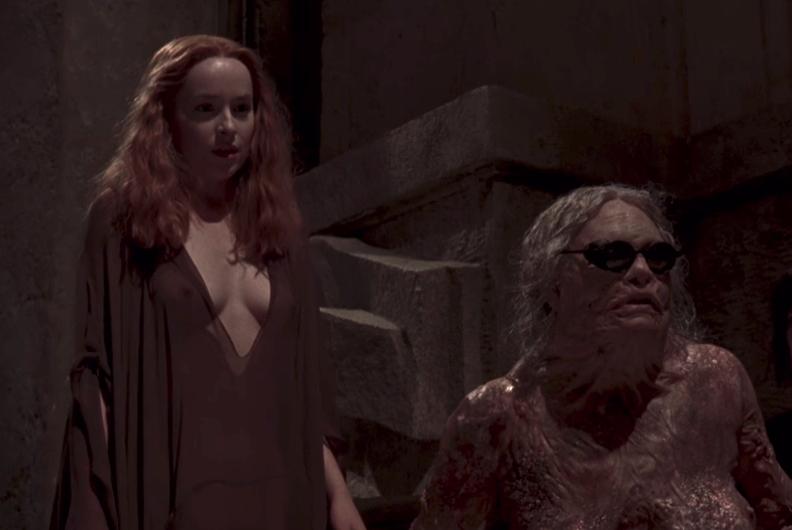
Suspiria 2018’s Susie Bannion is a rule breaker and catalyst for transformation.
Suzy’s name itself, besides the possible symbols it carries as discussed above, could be a good hint as well. The film seems to try to show that when Olga while bullying Sara and the newly arrived Suzy says that she once heard that names that start with the letter “s” are names of snakes, and the snake is referred to later on. Moreover, we can’t deny that Suspiriorum and Susanna share initials.
Suzy decides to find answers and reasons for the strange facts happening around her and while being informed by experts on occult matters about the true nature of the Markos academy and its director Helena Markos herself, Suzy expresses that what is being told to her by Dr. Frank (played by a young Udo Kier) is familiar to her, as if she already knew about all that. The elder expert Dr. Milius (Rudolf Schündler, do you remember him as the butler Karl in The Exorcist? We do; and we know about that crucifix, Karl) also tells her that “a coven is like a serpent”, when explaining that the head of a coven is its source of power and when a coven has no head it is totally inoffensive like a headless cobra.
The final sequence shows an enraged Madame Blanc (played by a marvelous Joan Bennett) on her throne inside the hidden rooms of the academy, saying that the American girl must vanish. In the final confrontation, Helena Markos herself tells Suzy she’s been “expecting her” — now that sounds like more than just an ordinary desire for witness elimination, and maybe the coven had knowledge of an old prophecy of sorts about someone who would come for them, so they were trying to act in Herod’s manner to secure the throne (this Herod factor fits well the Snow-White tale which inspired Argento) — or maybe they just realized how powerful and clever Suzy was and decided to get rid of a potential predator and competitor.
Finally we see the first Suzy also putting an end to a passe order of witches, anyway, however doing it by flames (and you can tell how joyful she is when she leaves the academy in a most perfect “mission accomplished” expression!).

Suzy (Jessica Harper) escapes at the end of 1977’s Suspiria.
If these and other possible connections are conscious deliberate decisions taken after some genius interpretation of the original plot or if these are some of the finest examples of unconscious manifestations of symbolism, is yet to be known.
Daria Nicolodi, co-author of Suspiria (1977) and Inferno (1980) – the stylish continuation of Suspiria which was successful in keeping up with the atmosphere of the first film of the trilogy of the Three Mothers in which Daria also plays the part of a countess – is actually responsible for the plot of a school that hides an occult background (which is, according to her, something that happened in her family) and also for the insertion of the Three Mothers mythology to the plot. She expressed in an interview that she is the only person who knows the end of the story and that there is another Mother to be explored: Levana. Daria says she was not consulted for the making of Mother of Tears, the third episode of the trilogy, and that the film is not the actual conclusion of the story (we dare to say the film is not a conclusion to anything. Period. And let’s not even mention the Levana from the incredibly messy Il Gatto Nero (1989) aka Demons 6: De Profundis, but, oh, we just did…).
Now Levana, this Roman deity that rules over childbirth was associated with the goddess Artemis in her role as protectress of childbirth and is the character that appears in the title of the essay from where the names of the Three Mothers were taken, “Levana and Our Ladies of Sorrow”, part of the fragmentary and unfinished collection of fantastic essays from 1845 by the English writer Thomas De Quincey grouped under the title of ‘Suspiria de Profundis’ (sighs from the depths). De Quincey imagines the character of Levana accompanied by three sisters that mimic the triplicity of the Parcae, Furies and Graces: Mater Lachrymarum, Mater Suspiriorum and Mater Tenebrarum, Latin names for Mother of Tears, Mother of Sighs, and Mother of Darkness.
Levana’s role in child birthing is related by Quincey to the reality of sorrows: to be born is to realize the nature of this world. However, Levana, from the Latin levare (to uplift) was represented by the act of raising up the newborn by one of the people present as a life affirming act. De Quincey goes on to explain that Levana was tutelary of human education as well. The plots for the Suspirias (and Inferno, for that matter) surround educational centres and its students, i.e., the dance school and the music college in Rome where Mark (lived by the splendid Leigh McCloskey of whom we should talk one of these days) studies. However, as De Quincey explains, Levana’s educational program is not that of the grammars and schools, but an internal one and she is aided by the ministries of passion, strife and temptation to achieve the ends of her syllabus. “If, then, these are the ministries by which Levana works, how profoundly must she reverence the agencies of grief.” says the text.

Mark (Leigh J. McCloskey ) is a witness to the agencies of grief in Inferno (1980).
Interestingly, the Hebrew term levanah (לְבָנָה) is a word for “moon”. Notice how similar it is to the Latin name Levana or even to the Latin word for moon itself, luna. This word can also be seen in the monthly Jewish ritual of the sanctification of the new moon, or the Kiddush Levanah, a ritual performed in obedience to Exodus 12:2 as a form of saluting the Shekhinah — the Divine Presence, an aspect long regarded by Kabbalists to be feminine, a concept not be taken lightly in contemporary neopagan or psychoanalytic views, though. Influential occultist Dion Fortune (whose real name, by the way, was also that of a flower, Violet) recorded in her celebrated occult novel The Sea Priestess — yet to be made into a glamorous film one day — that:
“Our Lady is also called the Moon, called of some Selene, of others Luna, but by the wise Levanah, for therein is contained the number of her name.”
The Lilithian theme is visible in De Quincey’s essay when it informs the reader that “every captive in every dungeon; all that are betrayed and all that are rejected outcasts by traditionary law, and children of hereditary disgrace, — all these walk with Our Lady of Sighs”. Well, that we believe could be the very definition of the Lilithian image of witches: outcasts that are powerful by being outcasts.
Back to cinema, we see that both Suspirias – as well as Inferno – are tales about the strife of growing up and the self-blooming through the suffering, the tears and the grief that comes along with being born. In virtually all spiritual currents it is told that initiations bring about some good amount of suffering, for there’s no true learning without pain (Nietzsche has just winked) since the simple fact of becoming aware means being able to see the sorrows of this world in a clear cruel way. In Inferno, Mater Tenebrarum makes clear that she is bringing about Mark’s transformation. De Quincey’s Mater Tenebrarum, the Mother of Darkness, finishes her soliloquy saying:
“So shall he rise again before he dies, and so shall our commission be accomplished which from God we had, — to plague his heart until we had unfolded the capacities of his spirit.”
Yes, we know all of this is a bit of a cathartic textual musing with huge chunks of pure speculation (as is almost any creative exercise) and once again I must go back to the beautiful words of De Quincey, as he wisely puts it: “Theirs were the symbols; mine are the words.”
In the end we all realize that speech is silver, but silence is golden, and that, dear reader, is another fairy tale for another bedtime.
